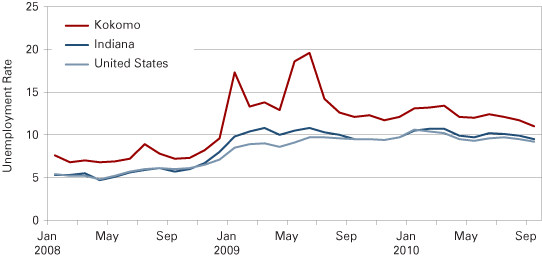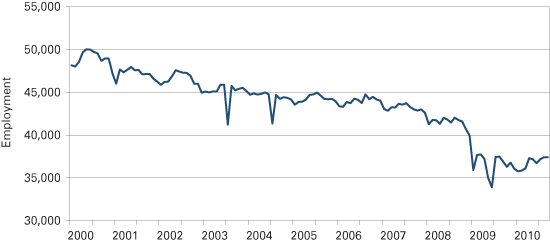Kokomo Forecast 2011
Assistant Professor of Economics, Indiana University Kokomo
After the worst two-year stretch in recent memory, the local economy in Kokomo is finally starting to show signs of improvement. Large-scale investments at some of the area’s largest manufacturing facilities have led to increased job opportunities and optimism. This change in attitude can even be seen in the national media, as Kokomo has gone from one of “America’s fastest-dying towns”1 to a “town back from the brink.”2
Employment
Unemployment rates in 2010 have been declining, with rates above 13 percent for the first three months, rates above 12 percent for the next four months, and rates below 12 percent in August and September. As seen in Figure 1, the unemployment rate has remained above both the national and state averages for the entirety of the past three years, but it has been closing the gap since June 2009, especially in the third quarter of 2010. This decrease has occurred in spite of an increase in the number of people who have resumed their job search this year (the labor force increased by approximately 2.2 percent since January). Combining this information with recent news about investment and hiring at Chrysler, Delphi and Abound Solar Inc. indicates that the local economy is trending in the right direction in recent months and should continue to do so in the near future.
Figure 1: Unemployment Rate Comparison, January 2008 to September 2010

Source: IBRC, using Bureau of Labor Statistics data
However, if a longer view is taken, a disturbing trend has emerged over the past 10 years. More than 12,600 jobs have left the Kokomo area since its peak employment level in May 2000, a decline of 25 percent (see Figure 2). The rate of job loss is far exceeding the rate of population decline, which points to future problems in both the labor market and housing market if the recent gains in employment are not sustained and built upon. Additionally, analysis of Howard County commuting patterns shows a net loss in population at the end of the work day, decreasing the amount of earned income that remains in the local economy.
Figure 2: Employment Trend for the Kokomo MSA, 2000 to 2010

Note: Hash marks indicate January and July of each year.
Source: IBRC, using Bureau of Labor Statistics data
Sector Analysis
Table 1 lists the five largest economic sectors in the Kokomo MSA based upon employment. Although manufacturing has taken a beating in the last decade, it still remains the largest sector, comprising nearly one quarter of all of the jobs in the area. A recent uptick in manufacturing activity and a growing health sector due to the area’s aging population have the local economy on the rise. As with the national economy, many of the other sectors such as retail and education will not see sizeable gains until the overall health of the nation’s employment improves.
Table 1: Sector Analysis for the Kokomo MSA, 2008 to 2010
| September 2010 | ||||
|---|---|---|---|---|
| Sector | 2008 | 2009 | Employment | Percent of Total Jobs |
| Manufacturing | 12,200 | 8,300 | 9,300 | 22.6% |
| Government | 7,800 | 7,500 | 7,500 | 18.2% |
| Retail | 5,600 | 5,200 | 5,100 | 12.4% |
| Education and Health* | 3,931 | 4,189 | 4,516 | 12.2% |
| Leisure and Hospitality | 4,500 | 4,200 | 4,400 | 10.7% |
*Data for this sector were unavailable for September, so a comparable measure was constructed using the most recent data available (March 2010).
Source: Bureau of Labor Statistics
Residential Real Estate
Residential real estate in the area has taken a tremendous hit recently, with an annual decline in prices exceeding 10 percent from the first quarter of 2009 to the first quarter of 2010.3 The Indiana Association of Realtors Real Estate Market Report for September is summarized in Table 2 using combined data for Howard and Tipton counties.4 There has been an increase of 12 percent in the number of closed sales in the first nine months of this year compared to the first nine months of last year. List prices have also increased by 9 percent comparing September 2009 to September 2010. FiServ has predicted a small loss in the median home price for the first quarter of 2010 through the first quarter of 2011, but predicts a 0.9 percent gain for the following year.5
Table 2: Residential Real Estate for the Kokomo MSA, Year-to-Date September 2009 to September 2010
| Residential Properties | 2009 | 2010 | Percent Change |
|---|---|---|---|
| New Listings | 1,558 | 1,478 | -5% |
| Closed Sales | 718 | 806 | 12% |
| Median Sales Price* | $69,450 | $75,500 | 9% |
*The median sales price shows data for Howard County only.
Source: Indiana Association of Realtors
Forecast
The short-term economic forecast for Kokomo is the best that it has been in several years. The Indiana Business Research Center is forecasting modest growth in area employment (above 1 percent in each of the next three years), while income growth in the area is forecast to outpace state increases, averaging over 4.4 percent per year for the next three years. Conexus Indiana is also forecasting income growth for the area, predicting an increase of nearly 18 percent in the area’s manufacturing income.
The long-term forecast depends on the area’s ability to continue to grow employment and retain its population. Additionally, the area needs to close the gap on educational attainment compared to national averages in order to diversify the job skills of the local workforce. The real estate market will continue to be stagnant, with little or no increase in property values for the coming year. In summary, the area should see steady growth in economic activity, particularly in manufacturing and health services, and positive (although smaller) growth in employment and real estate for the next year.
Notes
- Matt Woolsey, “In Depth: America’s Fastest-Dying Towns,” Forbes.com, December 9, 2008, www.forbes.com/2008/12/08/towns-ten-economy-forbeslife-cx_mw_1209dying_slide_9.html.
- “The Turnaround,” CNNMoney.com, accessed November 5, 2010, http://money.cnn.com/video/smallbusiness/2010/10/17/sbiz_kokomo_downtown_2.cnnmoney/.
- “Real Estate: Your Local Forecast,” CNNMoney.com, accessed November 4, 2010,
- These reports are archived at www.indianaishome.com/4_0_Reports.asp.
- See footnote 3.
Also in this Issue…
- Outlook for 2011
- International Outlook for 2011
- U.S. Outlook for 2011
- Financial Outlook for 2011
- Housing Market Outlook for 2011
- Indiana's Outlook for 2011
- Indiana's Agricultural Outlook for 2011
- Anderson Forecast 2011
- Bloomington Forecast 2011
- Columbus Forecast 2011
- Evansville Forecast 2011
- Fort Wayne Forecast 2011
- Gary Forecast 2011
- Indianapolis-Carmel Forecast 2011
- Kokomo Forecast 2011
- Lafayette Forecast 2011
- Louisville Forecast 2011
- Muncie Forecast 2011
- Richmond Forecast 2011
- South Bend and Elkhart Area Forecast 2011
- Terre Haute Forecast 2011




